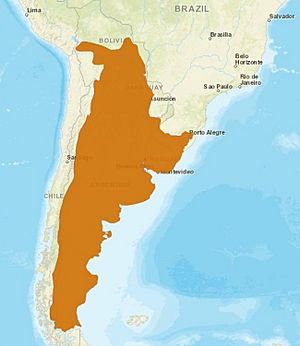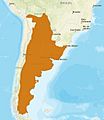Geoffroy's cat facts for kids
Quick facts for kids Geoffroy's cat |
|
|---|---|
 |
|
| Conservation status | |
| Scientific classification | |
| Genus: |
Leopardus
|
| Species: |
geoffroyi
|
 |
|
| Distribution of Geoffroy's cat, 2015 | |
| Synonyms | |
|
Oncifelis geoffroyi |
|
The Geoffroy's cat (Leopardus geoffroyi) is a small wild cat that lives in the southern and central parts of South America. It's about the same size as a regular domestic cat. This cat is found in many places and there are lots of them, so it's listed as "Least Concern" by the IUCN Red List. This means it's not currently in danger of disappearing.
Contents
About the Geoffroy's Cat
This cat is named after a French scientist named Étienne Geoffroy Saint-Hilaire. He lived a long time ago, in the 1800s. Two other French scientists, Alcide d'Orbigny and P. Gervais, officially named it Felis geoffroyi in 1844. They found some of these cats near the Rio Negro river in Patagonia.
Scientists used to think there were five different types, or subspecies, of Geoffroy's cat. But since 2017, they believe it's just one type of cat. Studies of its genes show that the Geoffroy's cat is most closely related to another small wild cat called the kodkod.
What Does It Look Like?
The Geoffroy's cat is similar in size to a domestic cat. However, it has many black spots all over its body. It also has dark stripes on its face, head, and neck, as well as on its tail and legs.
The color of its fur can change depending on where it lives. Cats in the northern areas might have brownish-yellow fur, while those in the south often have more grayish fur. Their belly fur is usually cream-colored or white. The backs of their ears are black with a white spot. Sometimes, you can even find completely black Geoffroy's cats! This is called melanism.
These cats are about 60 centimeters (about 2 feet) long from head to body. Their tail is fairly short, around 31 centimeters (about 1 foot) long. They usually weigh between 2 and 5 kilograms (about 4 to 11 pounds). Some bigger ones have been found weighing up to 7.8 kilograms (about 17 pounds). Male cats are usually larger than females. Also, Geoffroy's cats living in the southern parts of their range tend to be bigger than those in the north.
Where Do They Live?
Geoffroy's cats live in several countries in South America. These include Argentina, Bolivia, Brazil, Chile, Paraguay, and Uruguay. They like to live in open grasslands called pampas and savanna areas. You can find them in the Gran Chaco region, all the way from southern Bolivia down to the Straits of Magellan. They can live from sea level up to very high places, about 3,800 meters (12,500 feet) high, in the Andes mountains.
They prefer places with open woodlands or bushy areas that have lots of places to hide. But they also live in grasslands and wet, marshy areas. They are thought to be quite rare in Chile.
Life and Behavior
Geoffroy's cats are mostly active at night. They are solitary hunters, meaning they hunt alone. They only meet other Geoffroy's cats when it's time to mate.
One interesting thing about these cats is that they have been seen standing up on their back legs. They use their tail to help them balance, like a tripod. They do this to look around and see what's happening in their surroundings. This is not a common behavior for cats! They can climb trees, but they don't do it very often. When they do, it's usually to leave their droppings as a way to mark their territory.
These cats are at the top of the food chain in their habitats. They mostly hunt small animals like rodents, hares, and other small mammals. They also eat birds, snakes, small lizards, insects, and sometimes even frogs and fish. Female cats usually have a home area of about 2 to 6 square kilometers (about 0.7 to 2.3 square miles). Male cats have much larger areas, up to 12 square kilometers (about 4.6 square miles).
Reproduction and Life Cycle
Geoffroy's cats usually have their breeding season from October to March. During this time, the female cat is ready to mate for about 12 days. This happens every three to five weeks. When they mate, it's usually quick and happens often, sometimes in a high spot.
A female cat carries her babies for about 72 to 78 days. Most kittens are born between December and May. A mother usually has one to three kittens at a time, but one or two is more common.
When kittens are born, they are blind and can't do much for themselves. They weigh about 65 to 95 grams (about 2 to 3 ounces). They grow a bit slower than domestic cat kittens. Their eyes open after about 8 to 19 days. They start eating solid food when they are about six or seven weeks old. Kittens become independent from their mother when they are around eight months old. However, they are not ready to have their own babies until they are older. Females are ready at about 18 months, and males at about 24 months.
Conservation Efforts
From the 1960s to the 1980s, many Geoffroy's cats were hunted for their fur. Their pelts were sold around the world. But after 1988, not many furs were traded. In 1992, the species was given a special protection status called CITES Appendix I. This means it's one of the most protected animals.
Laws were made in the late 1980s that made it illegal to hunt Geoffroy's cats or sell their furs in countries like Argentina, Bolivia, Brazil, Chile, Paraguay, and Uruguay. Now, it's against the law to trade CITES Appendix I species internationally, unless it's for things like scientific research and not for making money.
Images for kids
See also
 In Spanish: Gato de Geoffroy para niños
In Spanish: Gato de Geoffroy para niños





